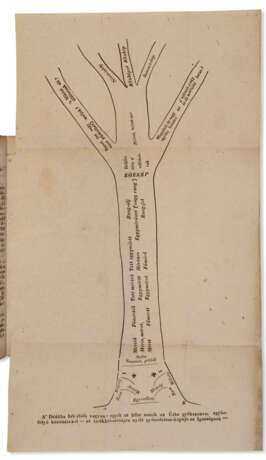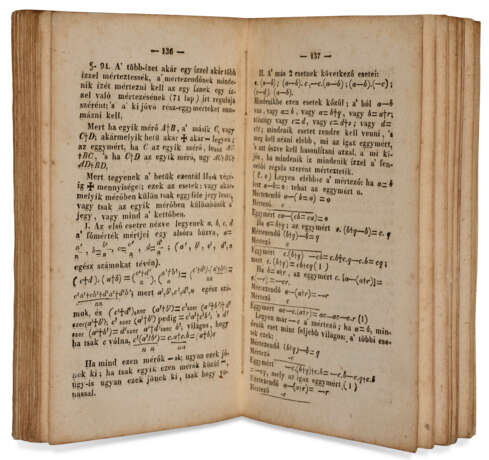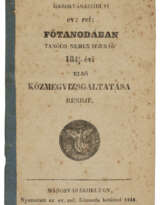ID 887778
Lot 5 | Az arithmetica eleje
Estimate value
$ 7 000 – 9 000
Exceptionally rare first edition of Farkas Bolyai's first mathematical publication: the precursor of his Tentamen. Association copy. This work is on the foundations of arithmetic, algebra, and analysis, and includes a discussion of Euclid’s parallel postulate, set theory, combinatorial analysis, calculus of variations, convergence of series, etc. It is in fact quite a mathematically advanced text, and was studied by Farkas’s son Janos, whose heavily annotated copy is in the Reform Kollégyom library in Târgu Mureș. It was Farkas’s son János who published, as an appendix to his father’s Tentamen, the epochal Appendix. Scientiam Spatii Absolute Veram exhibens, a foundation text for non-Euclidean geometry.
On 20 June 1831, Farkas wrote to Carl Friedrich Gauss an extraordinary letter, in which Bolyai says that he has written a work on the foundations of mathematics (the present work), which he published anonymously and in Hungarian. It is considered mathematically incomprehensible by his colleagues, apart from his own students and his son János. He writes that János is about to become a captain in the Engineering Corps and that—in addition to being an accomplished fencer, violinist, and given to dueling— he is a great admirer of Gauss. Farkas says that at his son’s request he is sending Gauss his Appendix, which will be published with his own Tentamen which is now in the press. This establishes that the Appendix was already printed by June 1831. His son requests Gauss’s opinion on the Appendix more than anything. Farkas adds a few comments about the mathematics of it, then says he has been trying to get ahold of Gauss’s first work, the Demonstratio nova (1799) and if Gauss has an extra copy to please send it (see Stäckel, Briefwechsel, pp 102-5).
Farkas Bolyai (1775-1856) was a close friend of Gauss and was regarded by the latter as the only man who fully understood Gauss’ metaphysics of mathematics. "He can be taken as a precursor of Gottlob Frege, Pasch, and Georg Cantor; but, as with many pioneers, he did not enjoy the credit that accrued to those that followed him" (DSB). He had worked on the parallel postulate and the possibilities of a non-Euclidean geometry from his earliest days as a mathematician in Göttingen, and had corresponded with Gauss on the subject, even sending him in 1804 a manuscript entitled "Theoria parallelarum," but it was his son János who was to achieve the breakthrough. See P. Stäckel, Urkunden zur Geschichte der nichteuklidischen Geometie. II: Wolfgang und Johann Bolyai. Geometrische Untersuchungen, Leipzig 1913 and Briefwechsel zwischen Carl Friedrich Gauss und Wolfgang Bolyai, Leipzig 1899. Poggendorf III 156. OCLC records just two copies.
Octavo (190 x 110mm). One folding plate (a few filled wormholes in blank margins). Original blue paper boards (backstrip reinforced, minor soiling). Provenance: Ferenc Musnai, Professor at the Reform College, friend of Bolyai, and author of a book of poetry with a preface by Bolyai (ownership signature dated 1830 on front free endpaper) – 19th-century manuscript passage on front free endpaper.
| Artist: | Farkas Bolyai (1775 - 1856) |
|---|---|
| Place of origin: | Eastern Europe |
| Auction house category: | Printed books |
| Artist: | Farkas Bolyai (1775 - 1856) |
|---|---|
| Place of origin: | Eastern Europe |
| Auction house category: | Printed books |
| Address of auction |
CHRISTIE'S 8 King Street, St. James's SW1Y 6QT London United Kingdom | |
|---|---|---|
| Preview |
| |
| Phone | +44 (0)20 7839 9060 | |
| Buyer Premium | see on Website | |
| Conditions of purchase | Conditions of purchase |



![Kurzer Grundriss eines Versuchs I. Die Arithmetik […] II. In der Geometrie](/assets/image/picture_3695444/2738a/eadbg48uqsbtyju1n4lvfepuz3tr1owekdzuohdxgbdeouha0gibqo77ffhjfjr11704446084jpg__fix_162_205.jpeg)





